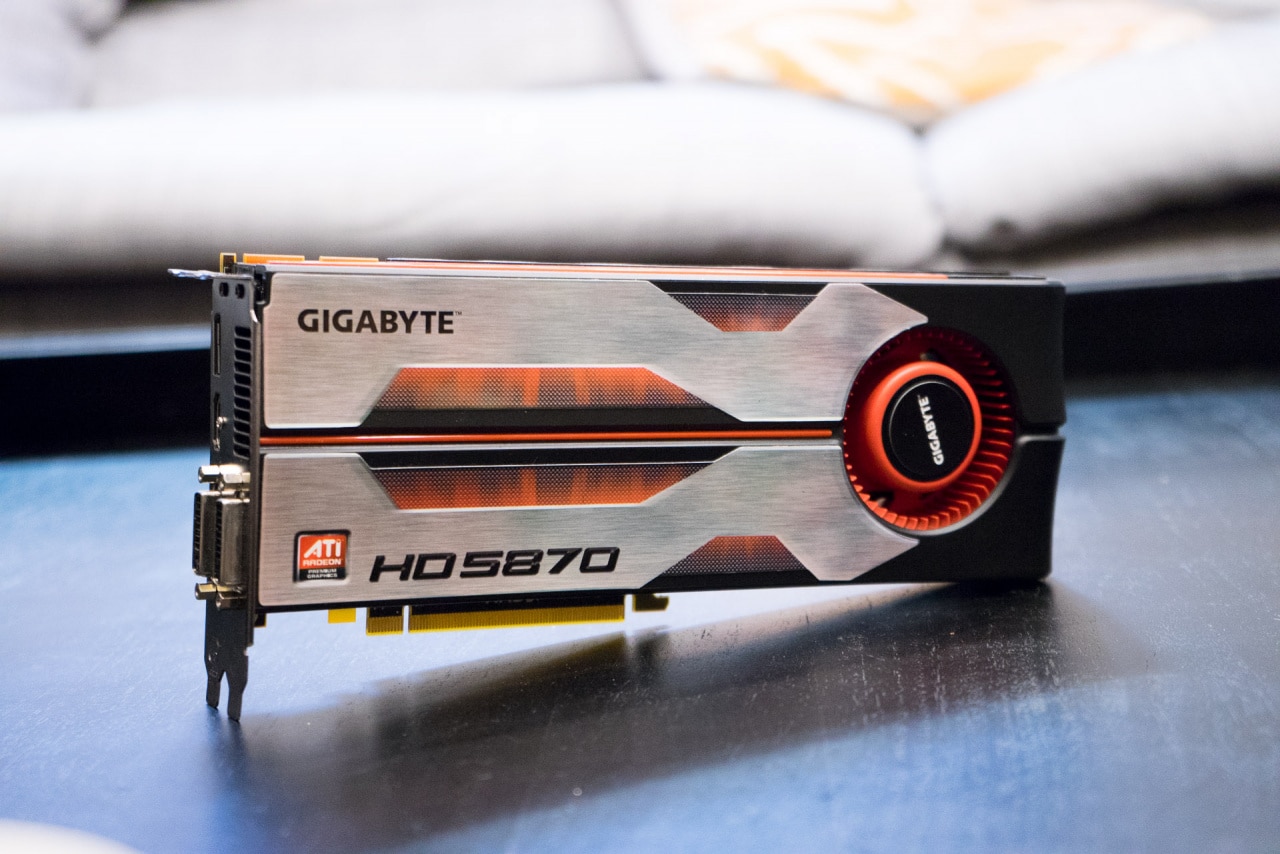In September 2009, a new graphics card family was introduced to the market that would set a new bar in the performance segment. On the menu was AMD’s, or ATI as their graphics division was called at the time, fresh architecture “Evergreen” which took the step down to manufacturing at 40 nanometers and doubled the number of transistors compared to the previous generation top cards.
First out according to the new architecture was the flagship Radeon HD 5870 with the code name “Cypress” which made seven laklives in terms of both performance and energy efficiency compared to previous cards. The shrunken manufacturing technology allowed the company to squeeze in 1,600 stream processors, which is double the 800 found on the Radeon HD 4890.
In terms of memory, AMD continued on the track with the then relatively new technology GDDR5 – a technology introduced a year earlier with the immensely popular model Radeon HD 4870. Radeon HD 5870 was initially equipped with 1 GB of GDDR5 memory on a 256-bit memory bus, which together with a memory speed of 4,800 MHz gave a memory bandwidth of over 150 GB / s.
The Radeon HD 5870 and the “Evergreen” architecture also introduced support for a couple of interesting technologies, including the DirectX 11 graphics interface that would be launched with Windows 7 a month later. Furthermore, the card was the first to offer the multi-screen technology Eyefinity, which allowed users to connect up to six screens and play on these at the same time for a truly immersive experience.
► Read SweClocker’s test of the AMD Radeon HD 5870
When the Radeon HD 5870 passed SweClocker’s test lab ten years ago, it was met with a predominantly positive impression from the editorial staff. The card was praised for its high performance and good energy efficiency, which together with a competitive price tag gave AMD a clear lead in the graphics market. The only caveat in the cup was poor accessibility, which was also the case a bit into the winter of 2009.
This is how the Radeon HD 5870 performs in 2019
Testing a ten-year-old graphics card in a modern test suite of games is usually problematic as there is no support for current versions of DirectX in the hardware. Here, the Radeon HD 5870 stands out by, despite its age, offering support for DirectX 11 and therefore we have the opportunity to tear off some fast performance tests.
As this is a very old graphics card that has not received new drivers since March 1, 2016, we really need to narrow down the selection of games, as many of those we have in the test suite refused to start or were tricked with instability together with Radeon HD 5870. In the end landed we with synthetic 3DMark Fire Strike as well as the games Destiny 2 and Rise of the Tomb Raider.
Not entirely unexpectedly, the Radeon HD 5870 lands very far down the table when 3DMark is on the menu, but this is not surprising given the age of the card. If you are going to draw a parallel to any product that is on the market today, the card is placed somewhere between AMD’s integrated Vega circuits in the Ryzen 3 2200G and 3 2400G processors.
As we roll on to the usual game tests, it is, as expected, the Radeon HD 5870 that lands at the bottom, with basically unplayable performance at these settings and resolution. However, we must say that the card does quite well against the competitor Nvidia’s Geforce GTX 480, which was released the following year.
Rise of the Tomb Raider also presents unplayable frame rate along with the Radeon HD 5870, but the same can also be said about the six-month-new Geforce GTX 480 which performs roughly equivalent to the AMD card in this title.
Destiny 2 | Rise of the Tomb Raider | |
|---|---|---|
“Ultra” | 23/16 | 15/12 |
High | 27/18 | 18/13 |
Medium | 34/24 | 27/23 |
Low | 44/32 | 33/29 |
Lowest | – | 40/34 |
Finally, we also take care to tweak the detail settings in the two games while maintaining the resolution at 1,920 × 1,080 pixels. As can be seen, it is possible to increase the frame rate above 30 FPS if the details are turned down in the basement and it would probably be possible to achieve a reasonably acceptable frame rate if the resolution was also halved to 1,280 × 720 pixels.
Summary thoughts on the Radeon HD 5870 ten years later
When we think back to the launch of the Radeon HD 5870, the most positive thoughts come to mind. For its time, the card offered really impressive graphics performance and energy efficiency without breaking the bank, and cemented AMD’s lead in the graphics card market until Nvidia launched the architecture “Fermi” and Geforce GTX 480 six months later.
The most fun thing about looking at the card’s performance today is not really seeing how few frames the model pushes out, but rather how far we have come in the last ten years with graphics technology, and not least the one that is integrated into processors. As an example, AMD’s latest Ryzen processors with integrated Vega graphics are faster than the company’s absolute graphics flagship in 2009 – which may not be surprising, but interesting nonetheless.
In summary, the Radeon HD 5870 was a really cool graphics card when it was launched ten years ago. It does not come close to the measure of today’s performance requirements in games, but it is still fun to see the card rolled a decade later in the test lab.
Did you own a Radeon HD 5870 when it went ten years ago? Share your experiences in the comment thread!















